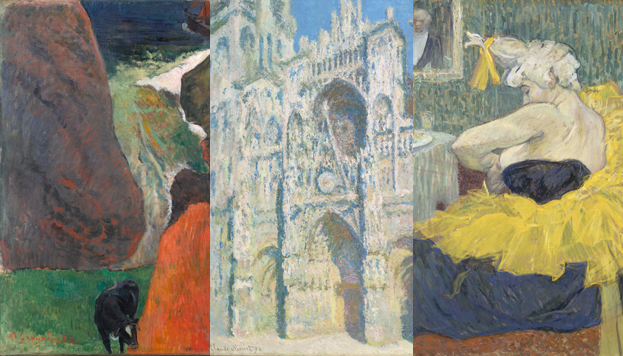The media have recently highlighted a marvelous coincidence: three exhibitions along the Prado-Recoletos cultural hub which mark the before and after of the Impressionist movement. It is a unique journey which brings to Madrid some of the most significant works by Monet, Renoir and Gauguin and which can be made in one day or over the course of a weekend.
My personal journey began at the Thyssen-Bornemisza Museum, with the exhibition entitled “Impressionism and Open-air Painting. From Corot to Van Gogh” which portrays the extraordinary revolution of open-air landscape painting, from Romanticism through to the dawn of the first avant-garde movements. I then carried on along Paseo del Prado, crossed Plaza de Cibeles and had breakfast at Café Gijón, a stone’s throw from the Mapfre Foundation’s Recoletos exhibition hall, where you can see “Impressionist and Post-impressionists. The Birth of Modern Art”. This title encompasses the different offerings which arise from the last exhibition held by the group in 1886. Here I found some of the most personal works of Monet and Renoir, as well as others which describe the path initiated by Cézanne, Seurat, Signac, Toulouse-Lautrec, Van Gogh, Gauguin and the Nabis, all from the Musée d’Orsay in Paris. I then strolled up Paseo de la Castellana to the Sorolla Museum, where paintings by Sorolla of his own garden are on display; in fact, his house and garden are just a few metres from the museum. That’s why it is better to visit the museum during the day, so be sure to take a bus (14, 27 and 150 all go along this avenue until Martínez Campos) if it’s getting near sundown, or go along to the museum early the following morning.

Seascape with Cow. 1888. Paul Gauguin. Rouen Cathedral. 1893. Claude Monet. The Clowness Cha-U-Kao. 1895. Henri de Toulouse-Lautrec.
The relationships that can be established between one exhibition and another are almost endless, as if one were the echo of the other. The question arising from the two small paintings by Pierre-Henri de Valenciannes, Loggia in Rome: Roof in the Shade and Loggia in Rome: Roof in the Sun, dating to the late 18th century and on display in the exhibition at the Thyssen-Bornemisza Museum, seem to respond to the two versions of Rouen Cathedral, painted by Monet in 1893 at different times of the day and on display in the first hall of the Mapfre Foundation exhibition. Because the journey which “Impressionism and Open-air Painting” makes in one direction is undone in the opposite direction by “Impressionist and Post-impressionists”. While one allows visitors to understand the key factors of the movement, the other convinces visitors as to its limitations and invites them to move forward to the avant-garde movements. While Corot, Courbet and Coignet went outside to accurately paint the unique light of the morning, afternoon or evening, Constable, Sisley and, later, Nolde were more concerned about capturing the effects of the rain, the movement of the clouds or the wind, as we learn from the exhibition at the Thyssen-Bornemisza Museum, arranged under such evocative headings as “rocks”, “mountains”, “trees” or “clouds”. Yet the question of whether it is possible to paint light seemed to have been inadequately resolved when Monet sought to capture the texture of the moment in the water lilies of his garden in Giverny or the sunset on the Thames during his visit to the Houses of Parliament in London, which are on display at the Mapfre Foundation exhibition.
The exhibition at the Thyssen-Bornemisza Museum places Impressionism within the European landscape tradition, inherited from Turner, Romanticism or the Barbizon School. And the exhibition at Sala Recoletos describes the need and urgency of the Impressionist masters, Monet and Renoir, and their followers, the Post-impressionists, to open new horizons having taken the principles of open-air painting to its very limits. This explains the search for solid elements in the paintings of Cézanne, the scientism of Seurat and Signac, the primitivism of the Pont-Aven School and the Nabis and the plastic expressiveness of Van Gogh. Degas and Toulouse-Lautrec also set out on a new adventure, that of reflecting modern life, cabaret, cafés and the world behind the scenes. (A note: at the Mapfre Foundation you can also see an exhibition which delves more deeply into this other line of work: “Lights of Bohemia. Artists, Gypsies and the Defining of the Modern World”).
The exhibition at the Sorolla Museum is the ideal dessert after this succulent dish of Impressionist and Post-impressionist art. It may seem trite, yet of all Spanish painters, Joaquín Sorolla was the most adept at absorbing this artistic revolution. The last of the three exhibitions brings together, under the title “Sorolla. Gardens of Light”, works which capture the effects of the sun on water, sand, rocks and, especially, plants and flowers. As well as views of the Alhambra in Granada and Los Reales Alcázares in Seville, the exhibition includes paintings which the artist made of the Andalusian garden at his own house, now a museum; whereby this exhibition offers a dialogue between art and nature. Now I just need to find a quiet corner in this mini landscape where I can sit down and paint.